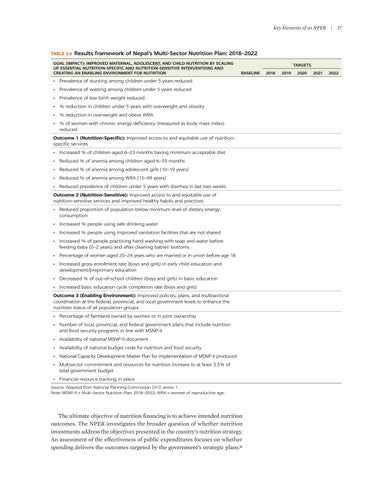Key Elements of an NPER
TABLE 3.6
|
37
Results framework of Nepal’s Multi-Sector Nutrition Plan: 2018–2022
GOAL (IMPACT): IMPROVED MATERNAL, ADOLESCENT, AND CHILD NUTRITION BY SCALING UP ESSENTIAL NUTRITION-SPECIFIC AND NUTRITION-SENSITIVE INTERVENTIONS AND CREATING AN ENABLING ENVIRONMENT FOR NUTRITION
TARGETS BASELINE
• Prevalence of stunting among children under 5 years reduced • Prevalence of wasting among children under 5 years reduced • Prevalence of low birth weight reduced • % reduction in children under 5 years with overweight and obesity • % reduction in overweight and obese WRA • % of women with chronic energy deficiency (measured as body mass index) reduced Outcome 1 (Nutrition-Specific): Improved access to and equitable use of nutritionspecific services • Increased % of children aged 6–23 months having minimum acceptable diet • Reduced % of anemia among children aged 6–59 months • Reduced % of anemia among adolescent girls (10–19 years) • Reduced % of anemia among WRA (15–49 years) • Reduced prevalence of children under 5 years with diarrhea in last two weeks Outcome 2 (Nutrition-Sensitive): Improved access to and equitable use of nutrition-sensitive services and improved healthy habits and practices • Reduced proportion of population below minimum level of dietary energy consumption • Increased % people using safe drinking water • Increased % people using improved sanitation facilities that are not shared • Increased % of people practicing hand washing with soap and water before feeding baby (0–2 years) and after cleaning babies’ bottoms • Percentage of women aged 20–24 years who are married or in union before age 18 • Increased gross enrollment rate (boys and girls) in early child education and development/preprimary education • Decreased % of out-of-school children (boys and girls) in basic education • Increased basic education cycle completion rate (boys and girls) Outcome 3 (Enabling Environment): Improved policies, plans, and multisectoral coordination at the federal, provincial, and local government levels to enhance the nutrition status of all population groups • Percentage of farmland owned by women or in joint ownership • Number of local, provincial, and federal government plans that include nutrition and food security programs in line with MSNP-II • Availability of national MSNP-II document • Availability of national budget code for nutrition and food security • National Capacity Development Master Plan for implementation of MSNP-II produced • Multisector commitment and resources for nutrition increase to at least 3.5% of total government budget • Financial resource tracking in place Source: Adapted from National Planning Commission 2017, annex 1. Note: MSNP-II = Multi-Sector Nutrition Plan: 2018–2022; WRA = women of reproductive age.
The ultimate objective of nutrition financing is to achieve intended nutrition outcomes. The NPER investigates the broader question of whether nutrition investments address the objectives presented in the country’s nutrition strategy. An assessment of the effectiveness of public expenditures focuses on whether spending delivers the outcomes targeted by the government’s strategic plans.16
2018
2019
2020
2021
2022

